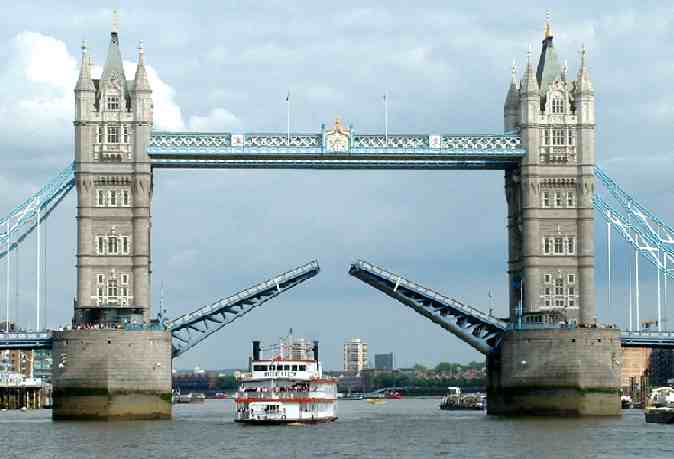The 99-year-old, two-lane red steel bridge over the river's North Branch will be replaced by a four-lane suspension and cable-stay bridge, the first of its kind in the city, said Cheri Heramb, the Chicago Department of Transportation's acting commissioner.Now while this is welcome news to those (including me) who detest navigating the Yuppie Hell Canyon (North Avenue between said bridge and Halsted) on weekends and rush hours, it is a bittersweet development. The report notes that
The existing bridge is one of the famed Chicago-style trunnion bascule bridges. The leaves are suspended on axles with counterweights--bascule means seesaw in French--and the steel trusses are noted for their curved profile.
What a fabulous description--there's something about a basic thing that, when it's named in French, transforms into another thing infinitely more enchanting. I mean, think of saying assistant instead of aide-de-camp, overthrow instead of coup d'etat, and "last show of the year" instead of season finale.
 Apparently Chicago is known for the trunnion bascule bridge. No two are exactly alike, and others are found spanning the Chicago River downtown at Clark and LaSalle streets, and the world's second-longest is at Columbus Drive. The most famous bascule bridge is the Tower Bridge across the Thames in London.
Apparently Chicago is known for the trunnion bascule bridge. No two are exactly alike, and others are found spanning the Chicago River downtown at Clark and LaSalle streets, and the world's second-longest is at Columbus Drive. The most famous bascule bridge is the Tower Bridge across the Thames in London.Chicago's first bascule bridge was built across the North Branch at Cortland Avenue in 1902.
It's funny that the North Avenue bridge is being replaced, because the Cortland bridge has been recently rehabilitated. I live near the bridge; much of my routine travel spans that bridge -- to the grocery, biking to work, to the lakefront, Second City, the mattress store, Armitage Avenue to look for overpriced paper and plastic rings.
 Florid name aside, I am fascinated by this bridge. There's a dedication plaque on either side, emblazoned with the name of a Chicago mayor whose father was also a mayor, assassinated in 1893 (a crime featured in the excellent Devil in the White City) and born in, of all places, Lexington, Kentucky, my own home. Carter Harrison, Jr., benefactor of the Cortland bridge, was elected in 1897 and served five terms, something his father probably would have done had he not met an untimely demise, shot after giving the closing address at the 1893 World's Columbian Exhibition on the South Side of Chicago.
Florid name aside, I am fascinated by this bridge. There's a dedication plaque on either side, emblazoned with the name of a Chicago mayor whose father was also a mayor, assassinated in 1893 (a crime featured in the excellent Devil in the White City) and born in, of all places, Lexington, Kentucky, my own home. Carter Harrison, Jr., benefactor of the Cortland bridge, was elected in 1897 and served five terms, something his father probably would have done had he not met an untimely demise, shot after giving the closing address at the 1893 World's Columbian Exhibition on the South Side of Chicago. A smaller plaque is found on one of the bridge's thrusts, a boasting reminder that the only thing Carter H. Harrison hefted to open this bridge was probably some scissors to cut a ribbon across its freshly-painted span in 1902. Apparently American Bridge Company was newly-formed in 1901, and soon monopolized the nation's bridge industry and manufactured steel as well. Kind of like the Clear Channel of the turn of the last century.
A smaller plaque is found on one of the bridge's thrusts, a boasting reminder that the only thing Carter H. Harrison hefted to open this bridge was probably some scissors to cut a ribbon across its freshly-painted span in 1902. Apparently American Bridge Company was newly-formed in 1901, and soon monopolized the nation's bridge industry and manufactured steel as well. Kind of like the Clear Channel of the turn of the last century. My favorite part of the bridge is the bridge house, about which I could find no historical information (Google, you tried). Maybe, then, it's just there to be enjoyed, a quiet, tree-shaded place to pause and soak up history buttressed by massive red steel wings.
My favorite part of the bridge is the bridge house, about which I could find no historical information (Google, you tried). Maybe, then, it's just there to be enjoyed, a quiet, tree-shaded place to pause and soak up history buttressed by massive red steel wings.
No comments:
Post a Comment